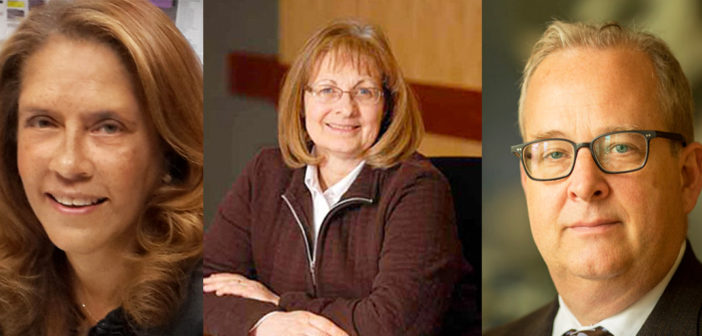More Mountain Hawks are flocking to campus, and Lehigh is rolling out the red carpet for them.
Lehigh already boasts new housing, a different bus system, multiple building renovations and a new College of Health, with more to come.
While these additions are partially aimed at drawing more applicants through Lehigh’s Path to Prominence, Georgette Phillips, the dean of the College of Business, views increased student enrollment as an opportunity to grow into a more research-focused institution.
“The Path to Prominence is much more than adding students,” Phillips said. “Simply adding undergraduate students does not put us on a different trajectory — we also must address research and infrastructure.”
This story documents the responses and opinions of several members of Lehigh’s senior leadership team regarding the impacts of increased student growth. Read here for a related story documenting the perspectives of several members of Lehigh’s Student Senate, staff and faculty.
The increasing student body catalyzes the need for experiential learning and new faculty to teach different areas of study. This concentration of research resonates among the deans of each college.
Steve DeWeerth, the dean of the P.C. Rossin College of Engineering, said his goal is to offer new programs that integrate some component of data intelligence systems and computation, and to do so, faculty are growing in that area.
“One hundred new faculty members now means we can go in new directions with research, do more interdisciplinary interactions, expand our scholarship,” DeWeerth said. “I really feel as though we’re evolving the role of the faculty member.”
DeWeerth said he is excited to see a diversified applicant pool, which he hopes will bring in more first-generation students.
The new College of Health, especially with its population health and healthcare focus, has the opportunity to fulfill these goals in research and an expanded curriculum.
“There are societal impacts that we are making,” Phillips said. “That’s a statement. But the exciting thing is that we have a College of Health. It’s an opportunity to say, ‘Let’s do something different.’”
However, the overlap between the College of Health and the College of Arts and Sciences could pose challenges.
Interim Dean of the College of Arts and Sciences Diane Hyland discussed planning adjustments this academic year to account for growing interest in international relations and political science. With the College of Health soon to open, there could be a shift toward science majors that would affect the College of Arts and Sciences once again, but Hyland believes her office could manage.
“Next year, planning will be much harder, because the College of Health will be on board, and the largest number of majors in CAS will be biological sciences pre-med,” Hyland said. “Now, if they switch to the College of Health, that will be a big change. But basically, we know what we’re doing.”
Whitney Witt, the inaugural dean of the College of Health, declined to comment.
Henry Odi, the deputy vice president and associate provost of Academic Diversity, said the university’s growth could help it become an R1 university — one with the highest research activity. Lehigh is currently an R2 institution.
Pat Johnson, the vice president of finance and administration, said Lehigh has the capability to grow and attract students to new programs.
“We’re an in-between university,” Johnson said. “The student body growth will put us in a competitive position as a research university, but still have a niche based on our residential and experiential learning opportunities.”
Faculty demographics could also change.
Hyland said 77 of the 260 CAS faculty are at least 60 years old. She said faculty retirements will give the college new opportunities to think strategically about how to move forward.
The changes affect staff too. For Johnson, the impact of Lehigh’s new retirement plan, for staff whose number of years with the university and age combined equal at least 75, has resulted in the loss of 20 people in her office including the treasurer, controller, associate controller, and budget director.
Johnson is optimistic about these changes and identifies them as an opportunity to “perform processes differently than before.” Not all of the positions are anticipated to be refilled.
Johnson advocated for a shared services model, where the duties of a specific role are shared by multiple people to increase efficiency. Lehigh administration is looking to gradually implement this model as well.
“Look at the engineering school, arts and sciences, controls office — less people,” Johnson said. “There’s the same amount or more work for (fewer) staff. As we look at hiring now, we look for people who have the capacity to be able to work differently.”
Ric Hall, the vice president for student affairs, said his office would reevaluate job responsibilities if the opportunity arose.
“There’s not just a one-to-one correlation between size of staff and number of students,” Hall said. “We sometimes have to be creative in our assessment of staff responsibility, especially with staff departures.”
Hall acknowledges the need for growth in offices to provide adequate resources for more students, including the health center, counseling center and dining halls.
Dan Warner, the vice provost for Admissions and Financial Aid, said in an email to remember that growth occurs over time.
“Just because we have begun to grow, it does not mean we have 1,000 more undergraduate students on campus right now,” Warner said in an email. “The growth of students will be gradual, and I expect the growth of faculty, staff, and other resources to be of a similar pace.”
DeWeerth said the increase is also adaptable because the colleges are going to grow by 10 percent over 10 years — only a one percent growth per year.
Odi said he is “cognizant to the challenges growth brings.” The number of teaching assistants, course sections and eventual classroom, lab and residence spaces could all become impending problems.
“I anticipate major issues,” Odi said. “We’re starting to see them, (and they) are starting to be addressed. These increases are going to intensify for the need (for) services.”
Go: The Campaign for Lehigh has a $1 billion fundraising goal.
“The campaign is about capital: buildings such as residence halls, health buildings and Chandler-Ullmann,” said Johnson. “Very little of that goes to operating funds — only annual giving does.”
Warner said departments are given the opportunity to annually assess their budgets and submit requests for additional funding. His priority has been to increase initiatives to grow the prospective student pool rather than hire more staff.
“Not all of our requests can be approved in a given year, but I am appreciative that some additional funding was made available to admissions this year that will help with short and long term goals,” Warner said. “If there is a need to increase staff in the future, based on application numbers, visitors to campus, etc., I may request additional funding at that time.”
Odi recognizes that there will “never be enough money to do everything,” and said various offices across campus have not gotten the increased funds they have asked for.
“More money? No,” Odi said. “For the time I’ve been at Lehigh, I’ve never received everything that I’ve asked for. You become more strategic in your thinking in where you put the money and why, and assess the value and impact of the budget that you have from the university in addition to the funds that you charge from outside the university.”
However, Odi has confidence in his office’s responsibilities, which includes faculty recruitment and implementing inclusive excellence.
Travel schedules did not permit comments from President John Simon and William Gaudelli, the dean of the College of Education.
The Path to Prominence is bringing forth numerous structural and institutional changes, which are heavily discussed and integral to the goals of the university’s plans.
Students — particularly the increased quantity and diversity of students — are also beginning to drive these changes.
Lehigh’s class of 2023 boasts the largest class size the university has seen, at 1,406.
Hall said the first-year orientation rally had to occur in Stabler Arena, because Grace Hall could not accommodate the larger class.
“We’re never going back to Grace Hall,” Hall said. “Factor in getting the students up there, that’s an incurred cost for transportation, changes the orientation calendar because you have to allow for time to get the students back to campus.”
Many senior leadership members spoke positively on the goals and process of attaining this class.
For Warner, the recruitment and admission process changed this year because there was a target number of students to reach.
“It has allowed us to think differently about how we recruit, admit and enroll students,” Warner said. “The goals of growing the total undergraduate population and expanding our reach to underrepresented geographic, ethnic, racial and socioeconomic markets means that we are scaling up some things we were doing in the past, dropping others and implementing some new things.”
Odi said Admissions needed to be careful not to sacrifice the quality of students to hit the enrollment numbers, because there would be an adverse impact.
“It cannot be the same strategy that we’ve deployed for a number of years,” Odi said. “Moving forward, it’s not going to work. And then the question(s) will be: What will the new strategies be? What will that include? What will that look like?”
Recruiting a diverse population of international student’s is one of the responsibilities of Cheryl Matherly’s office.
“We remain very focused on increasing our competitiveness with making Lehigh a destination of choice for all students,” Matherly, the vice president and vice provost of International Affairs, said in an email.
Initiatives have included the Global Lehigh Strategic Plan, Passport to Success, and hiring a staff person to be based in India, which is especially significant to increase recruitment and access in the area.
Warner recognizes that the applicant pool only increased slightly between 2018 and 2019. However, he said “the quality of the students was notably higher,” which allowed the university to maintain the caliber of incoming students.
Phillips believes metrics such as student attributes, early decision applicants and valedictorian status are important. However, the student’s natural drive is the ultimate factor she looks for.
“There is no standardized metric for curiosity and at the end of the day, that’s what you want…” Phillips said. “Curiosity is a proxy for intelligence — that’s the student I want sitting in my class.”
Hyland said accommodations should be made for students throughout this growth process — not just in academics, but also in other areas.
“There are not just more students, (there are) different types of students,” Hyland said. “We’ll have more students from underrepresented groups. Students with mental health needs and needs for counseling, a variety of learning styles. These are people as well, more of these people will present more challenges. There will be real needs that we can’t forget.”
Odi echoed this sentiment. Using the health center as an example, he said that the quality of services students need must be provided.
“When you increase one population, it directly impacts the other communities,” Odi said. “In this case, undergraduate students will affect everything else.”
Warner sees “only upside” in the opportunity to educate and provide opportunities for more future Lehigh alums, who will then take “Lehigh values out into the world.”
Odi said with great challenges come great opportunities — and the chance to make Lehigh a household name in communities throughout the country, and the world.
“Reputation is the quality of students that we are recruiting, the quality that we are graduating, the quality of the staff and faculty and what they are delivering, the research and scholarship — all are really going to play into the national and international equation,” Odi said.
This report was compiled by The Brown and White’s Investigative Team.






Comment policy
Comments posted to The Brown and White website are reviewed by a moderator before being approved. Incendiary speech or harassing language, including comments targeted at individuals, may be deemed unacceptable and not published. Spam and other soliciting will also be declined.
The Brown and White also reserves the right to not publish entirely anonymous comments.